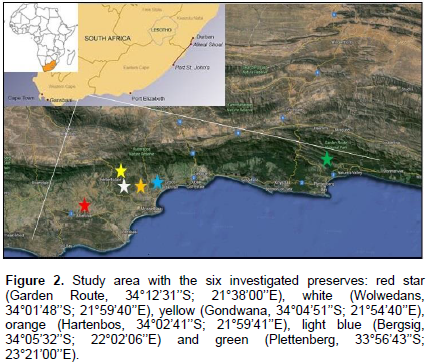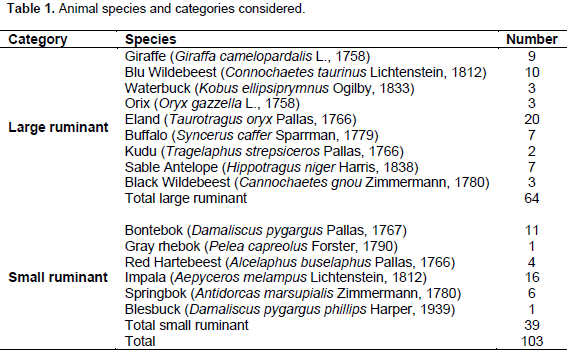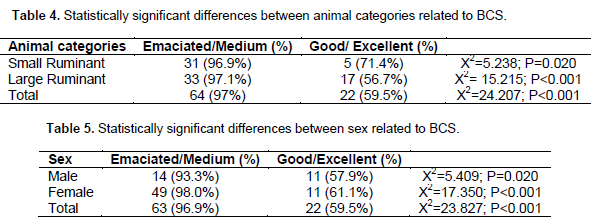ABSTRACT
A survey on wild ruminants’ health status of any South African preserves was attempted, assessing body condition score (BCS) through tele-diagnosis. The wildlife BCS was linked to the presence of gastrointestinal parasites that should be recognized, counted and statistically evaluated. For this purpose, we examined 103 faecal samples of wild ruminants from 6 South African preserves. For practical reasons, the animals were divided into two macro-categories: small and large ruminants. The results obtained showed a prevalence of 78.1 and 15.6% in large ruminants for gastrointestinal strongyles (GIS) and coccidian, respectively, while small ruminants showed 92.3% due to GIS and 30.8% for coccidia. No statistically significant difference in the prevalence among the preserves was detected; on the other hand, a low value of BCS corresponds to a greater presence of parasites with statistics difference in the macro-categories (small ruminant x2=5.238; P=0.020; large ruminant x2= 15.215; P<0.001) and sex classes (male x2=5.409; P=0.020; female x2 =17.350; P<0.001). For these reasons, our results provide a practical feedback for the management preserves. The present paper is fully part of the limited experiences of telediagnosis in a conservation perspective. Based on the results obtained, we decided to organize a project that could limit and assess the risk factors in the management of these activities in the South African context.
Key words: Wild ruminants, telediagnosis, parasites, body condition scores, South African preserves.
In recent past, Veterinary Medicine has focused its interest on involving wild animals not only as single head fenced in captivity and therefore clinically similar to domestic one, but also as free-living populations. All these are meant to protect biodiversity and curtail the possible spread of pathogens, and zoonotic diseases. These preliminary considerations suggest transferring the clinical approach proposed by Bologna Academy (Messieri and Moretti, 1982) and more recently by Cambridge Academy (Jackson and Cockcroft, 2002), simplifying and adapting them to wild ruminants in game preserves of South Africa. These are wild farms suitable for the conservation, including breeding of species of local wildlife particularly valuable, from economic, touristic or endangered point of view. Their management is quite particular: wild ruminants are fenced on many hectares of land and continuously exchanged with other preserves.
Considering that from this wild farm parasitological information are lacking and also domestic ruminants are raised close to wild ones, we suggested transferring the clinical approach cited adapting them to wild ruminants by a visual system for scoring body condition (telediagnosis). In the international literature, we have found four specific papers of this non-invasive method to define health status: two in Asian Elephants (Elephas maximus L., 1758) (Ramesh et al., 2011; Wijeyamohan et al., 2015) and two on wild ruminants, in particular Bassano et al. (2003) on Ovis canadensis (Shaw, 1804) and Capra ibex (L., 1758) and Pfeifer (2015) Cervus elaphus (L., 1758). The aim of this study was to survey the health status of wild ruminants by telediagnosis.
This was evaluated by scoring body condition. Body condition score (BCS) is a subjective tool to assess the amount of metabolizable energy stored in body fat (primarily subcutaneous) and muscle tissues of a live animal (Edmonson et al., 1989; Burkholder, 2000; Alapati et al., 2010). Body condition is an index of an animal’s health (Terranova and Coffman, 1997). An increase or decrease in body condition could mean a change in quality of management or environment in which an animal lives (Figure 1). The wildlife BCS should be linked to the presence of gastrointestinal parasites that should may be recognized, counted and statistically evaluated. These described assumptions have had to adapt to the preserves logistical and laboratory requirements provided. Another purpose to study the parasitism of wild ruminants should be to help their management by rangers.
Study area
Our survey was done in 6 preserves in the Eastern region of Garden Route, Republic of Sud Africa (Figure 2) during February 2016. The area has soil and weather characteristics that allow arid lands mixed with wetlands, characterized by particular kind of bush (named fynbos), especially suitable for game preserve activity aimed to the conservation of autochthonous flora and fauna.

Animals
Overall, we have had the opportunity to work with 103 animals belonging to 15 different ruminant species (Table 1). The adjustment of the clinical procedures applied to domestic animals provides general appearance and physical examination, excluding the medical history, since in wildlife it is impossible to know the history of individuals. The animals were identified through an optical instrument (field glass Olympus 10X50) at dropping time, later they were photographed and then classified according to sex (male, female) and category (small or large ruminants). The sex was determined in 102 animals, 34 males and 68 females, in one instance it was not possible because it was a very young individual and hidden from the herd. BCS was evaluated analysing the ribs, spine, hip bone/rump, tail head and belly, according to the method described by Pfeifer (2015). Randomly, the classification was simplified by grouping the animals into two main categories: emaciated/medium and good/excellent. Faecal samples were collected off the ground, marked with a serial number, scientific and common names of the species. Collected samples were stored in a cooler, transported in a few hours in a refrigerator (+ 4°C), and then in the laboratory examined.

Examined samples
Stool samples were referred for qualitative and quantitative coprological evaluation. It was realized with an alternative tool that stocks parasitic forms without centrifugal step (Mini- FLOTAC, Silva et al., 2013; Godber et al., 2015), using a floatation solution (specific gravity 1.3).
Statistical analysis
The study of prevalence for coccidia and gastrointestinal strongyles (GIS) was evaluated by comparing the sampling area, sex, and category (small or large ruminants) using chi-square test (χ2). All statistical analyses were performed using the software SPSS 23.0 (IBM SPSS Statistics, New York, United States).
Qualitative results
Overall, 86 of 103 (83.5%) analysed faecal samples were positive for parasites. Specifically, 86 samples were positive for gastrointestinal strongyles (GIS); and 22 (21.85%) of these were also positive for oocysts of coccidia. Two samples tested positive for whipworm and tapeworm eggs respectively (0.97%). Parasites prevalence was not statistically different (P>0.05) between small ruminants and large ruminants (Table 2). Statistically significant difference in the prevalence among the preserves was not detected (Table 3). However, there was a lower prevalence, albeit without statistical significance, of GIS in Wolwedans and lack of coccidia in Hartenbos. Even between sexes the parasitism seems to be equal.

Quantitative results
If we take into account the quantitative results, positivity at least one parasite (egg/oocyst), a statistically significant difference emerges for BCS levels and sex (Tables 4 and 5). In one head only positive for GIS we observed diarrhoea. The lack of previous surveys, the preserves management characteristics and the logistic difficulties led as to modify our initial project. This resulted during data elaboration to consider only the macro categories of ruminants (large and small) and other parasites (GIS and coccidia). For this purpose, it was particularly useful having available a diagnostic tool that allowed a field activity. Both macro categories created reflect the reality of the hosts/parasite/environment situation in the surveyed areas. The absence of the lower category of BCS supports the hypothesis of a natural predation by carnivore. Despite this simplification, our experience allows validating some results by the statistic help, which excludes the results randomness.

Also without the statistic help, the two parasites categories’ prevalence in large and small ruminants was higher anyway. This outcome should be justified in that large African ruminants like diet of trees and bushes that do not favor oro-faecal transmission cycle, characteristic of gastrointestinal parasites. According to the preserves’ situation, the different parasites’ prevalence could depend on Wolwedans in that it is organized like a true breeding unit (few hectares and small yards) with all characteristics management procedures, while the particularly dried environment of Hartenbos could limit the coccidian transmission that needs humidity to reach the infectivity stages. We did not find prevalence differences between sexes, but this was evident in both categories when related to BCS linked parasite prevalence both for GIS and coccidia. The presence of these parasites is significantly associated in both sexes. This data appear particular interesting for the characteristics of the preserves studied; one could benefit from the information relative to the crucial influence of parasites and BCS being able to hypothesize specific control activities.
For this reason, our results although limited in numbers and of simplified approach could have a practical feedback for the preserves management. In fact, if a bad BCS is related to the higher parasites presence same animals should be treated avoiding its loss and at the same time not interfere with the natural distribution of the parasites (Wilson et al., 2002). For a practical purpose, the animals that could benefit from treatment could be those fenced in small pens or captured for transport. Future updating should reduce the two macro categories correctly recognising the host species and identify parasites found in dead animals. In this regard, it is extremely interesting the experience carried out in the Limpopo National Park (South Africa) by Van Wyk and Boomker, (2011) where it was possible to isolate and identify the parasites species and the conclusions refer to the importance of parasites in the transfer animal, well known at our latitudes (Lanfranchi et al., 2003). The present paper is full part of the limited experiences of telediagnosis in a conservation perspective. Based on the results obtained, we decided to organize a project that could limit and assess the risk factors in the management of these activities in the South African context.
The authors have not declared any conflict of interests.
The authors would like to thank Natalie Bellet for English language revision.
REFERENCES
|
Alapati A, Kapa SR, Jeepalyam S, Rangappa SM, Yemireddy KR (2010). Development of the body condition score system in Murrah buffaloes: validation through ultrasonic assessment of body fat reserves. J. Vet. Sci. 11:1-8.
Crossref
|
|
|
|
Bassano B, Von Hardenberg A, Pelletier F, Gobbi G (2003). A method to weigh free-ranging ungulates without handling. Wildl. Soc. Bull. 31:1205-1209.
|
|
|
|
|
Burkholder WJ (2000). Use of body condition scores in clinical assessment of the provision of optimal nutrition. J. Am. Vet. Med. Assoc. 217:650-654.
Crossref
|
|
|
|
|
Edmonson AJ, Lean IJ, Weaver LD, Farver T, Webster G (1989). A body condition scoring chart for holstein dairy cows. J. Dairy Sci. 72:68-78.
Crossref
|
|
|
|
|
Godber OF, Phythian CJ, Bosco A, Ianniello D, Coles G, Rinaldi L, Cringoli G (2015). A comparison of the FECPAK and Mini-FLOTAC faecal egg counting techniques. Vet. Parasitol. 207:342-345.
Crossref
|
|
|
|
|
Jackson PGG, Cockcroft PD (2002). Clinical examination of farm animals Blackwell Science Ltd, Oxford.
Crossref
|
|
|
|
|
Lanfranchi P, Ferroglio E, Poglayen G, Guberti V (2003). Wildlife Veterinarian, Conservation and Public Health. Vet. Res. Comm. 27:567-574.
Crossref
|
|
|
|
|
Messieri A, Moretti B (1982). Semiologia e Diagnostica medica Veterinaria Libreria Universitaria L. Tinarelli Bologna. (In Italian).
|
|
|
|
|
Pfeifer A (2015). Differences in Body Condition of Elk, Cervus elaphus, by Location in Yellowstone's Northern Range' Poster produced by University of Washington School of Environmental & Forest Sciences.
|
|
|
|
|
Ramesh T, Sankar K, Quereshi Q, Kalle R (2011). Assessment of Wild Asiatic Elephant (Elephas maximus indicus) Body Condition by Simple Scoring Method in a Tropical Deciduous Forest of Western Ghats, Southern India. Wildlife Biol. Pract. 7:47-54.
Crossref
|
|
|
|
|
Silva LMR, Vila-Vicosa MJM, Maurelli MP, Morgoglione ME, Cortes HCE, Cringoli G, Rinaldi L (2013). Mini-FLOTAC for the diagnosis of Eimeria infection in goats: An alternative to McMaster. Small Rumin. Res. 114:280-283.
Crossref
|
|
|
|
|
Terranova CJ, Coffma BS, (1997) Body weight of wild and captive lemurs. Zoo Biol.16:17-30.
Crossref
|
|
|
|
|
Van Wyk IC, Boomker J (2011) Parasites of South African wildlife. XIX. The prevalence of helminths in some common antelopes, warthogs and a bushpig in the Limpopo province, South Africa. Onderstepoort J. Vet. Res. 78(1):1-11.
Crossref
|
|
|
|
|
Wijeyamohan S, Treiber K, Schmitt D, Santiapillai C (2015) A Visual System for Scoring Body Condition of Asian Elephants (Elephas maximus). Zoo Biol. 34:53-59.
Crossref
|
|
|
|
|
Wilson K, Bjornstad ON, Dobson AP, Merler S, Poglayen G, Randolph SE, Read AF, Skorping A (2002). Heterogeneities in macroparasite infectious: patterns and processes. in Hudson PJ, Rizzoli A, Grenfell BT, Heesterbeek H, Dobson AP (eds), "The Ecology of Wildlife Disease", Oxford University Press.
|
|